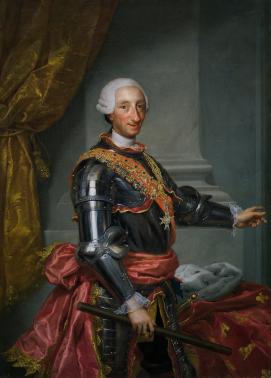Charles III

Bohemian 1728–1779, worked in Spain 1761–70, 1774–77
Charles III of Spain c.1761
oil on canvas
151.1 x 109.0 cm
Museo Nacional del Prado, Madrid (P02200)
Lived: 20 January 1716 – 14 December 1788
Reigned: 10 August 1759 – 14 December 1788
Married to Maria Amalia of Saxony.
The son of Philip V and Elisabeth Farnese, Charles III succeeded to the Spanish throne on the death of his half-brother Ferdinand VI, after already ruling as King of Naples for 25 years. His patronage reflected his personal interest in architecture and mechanics and during his time in Italy Charles instituted the construction of several important public buildings as well as commissioning two new palaces near Naples. These architectural projects led to the flowering of artistic productivity in the region, especially in the decorative arts. Charles III founded the Capodimonte Porcelain Factory, a majolica factory at the palace at Caserta, the Real Laboratorio delle Pietre Dure and a silk factory. The discovery of Herculaneum and Pompeii in the 1730s and 40s also stimulated artistic activity in Naples. Initially he did not collect works by the more gifted contemporary artists until encouraged to do so by his wife, Maria Amalia of Saxony. In 1759, Charles became King of Spain and he left Naples for Madrid accompanied by a large entourage that included the artist Mario Nani. He continued the decoration of the Palacio Real begun by his father, summoning the finest artists at the time to work on the project, including Anton Raphael Mengs (who became Director of Painting at the Royal Academy of Fine Art of San Fernando and then Chief Court Painter) and the three Tiepolos. The redecoration of the palaces required vast amounts of goods and furnishings to fill them so Charles III founded several factories in Spain that manufactured luxury goods exclusively for the royal residences - the Royal Tapestry Factory of Santa Barbara, the porcelain factory at the Buen Retiro, The Real Laboratorio de Piedras Duras and the existing Real Fábrica de Vidrio y Cristal at San Ildefonso was enlarged. But his greatest legacy was transforming Madrid into a modern city with a main tree-lined boulevard, street lighting, and an integrated sewage system.
Charles III also enlarged the Royal Collection through purchase. Unfortunately his taste was governed by his zealous puritanism that led him to request the destruction of the finest nudes in the Royal Collection, including masterworks by Titian, Tintoretto and Veronese. They survived only through the intervention of Mengs and were confined to the Buen Retiro Palace and the Casa de Rebeque.